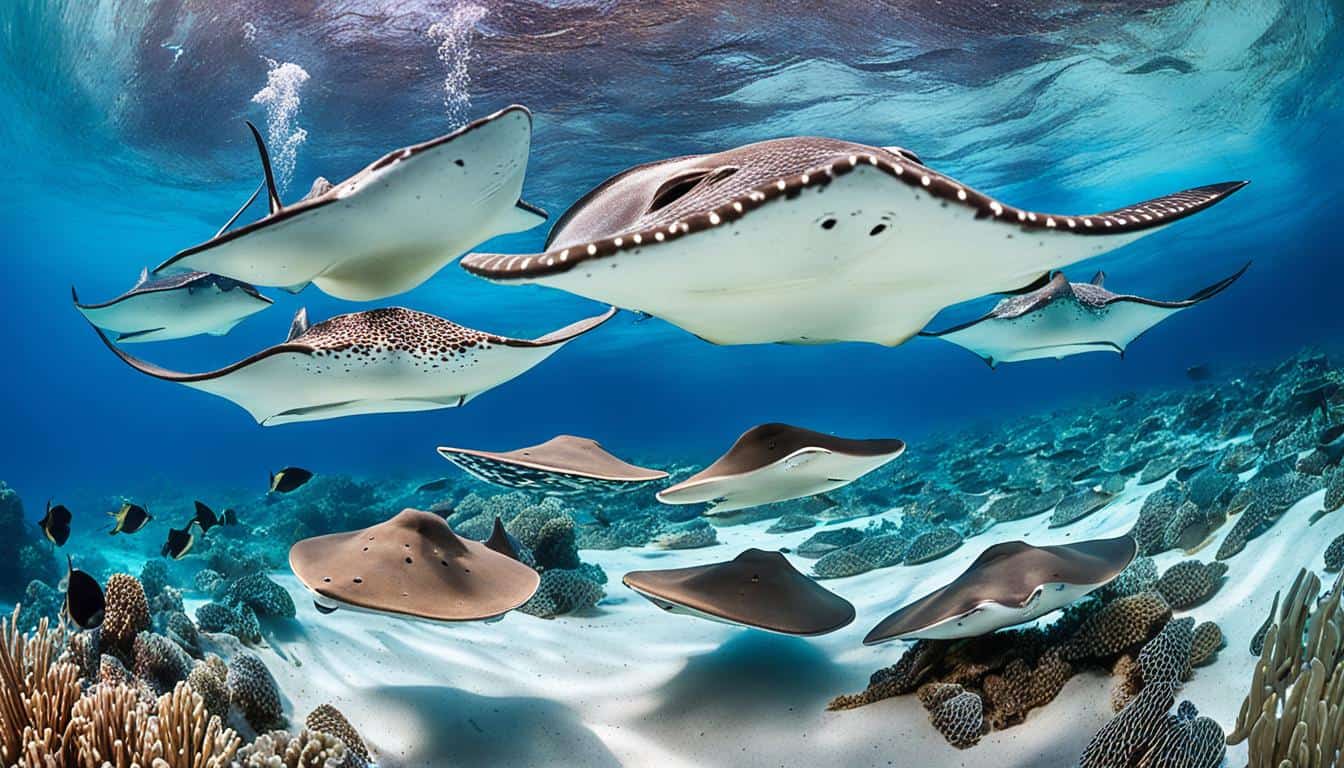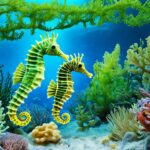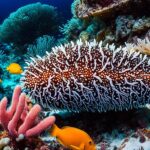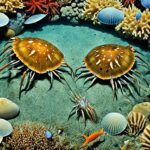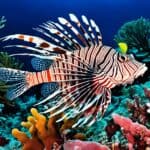In the vast ocean, it’s important to know how stingrays interact with other sea creatures. These creatures have special ways to live together with many species. By looking at their social life, what they eat, and how they talk to each other, we learn how stingrays live in the sea and help keep it healthy.
Understanding Stingray Behavior in Marine Ecosystems
Stingrays are key players in the ocean, showing interesting behaviors and ways of living. By looking at southern stingrays, we learn about their traits and how they interact with other sea beings.
Characteristics of Southern Stingrays
Southern stingrays have flat, diamond-shaped bodies perfect for living near the ocean floor. They blend in with the sand thanks to their olive-green or brown color. This helps them move undetected through their underwater world, which is crucial for survival.
Feeding Habits and Interactions
To understand southern stingrays, we must look at how they eat. They hunt on the ocean floor, using special senses to find hidden food. Their diet includes clams, crustaceans, small fish, and other sea creatures. This shows how important they are in the ocean’s food chain.
They hunt at night and during the day, which affects how they interact with other sea animals.
| Feeding Adaptation | Description | Impact on Ecosystem |
|---|---|---|
| Ampullae of Lorenzini | Specialized organs that detect electrical signals from prey | Enhances foraging efficiency, affecting prey population dynamics |
| Bottom Disturbance | Stirring up sediment to uncover hidden prey | Redistributes nutrients, supporting diverse marine life |
| Nocturnal Foraging | Active feeding during the night | Reduces competition with other daytime feeders |
These behaviors show how stingrays interact with other sea animals. It highlights their vital role in the ocean’s balance.
How do stingrays interact with other marine life?
Stingrays are key players in marine ecosystems. They help shape the balance by eating mollusks, crustaceans, and small fish from the sand. This eating habit changes the number of these creatures and affects the ecosystem’s health.
When stingrays move, they stir up the sand, drawing in other sea creatures. Birds, for instance, follow them to catch fish that flee in fear. Stingrays can sense electric fields, which helps them find food and avoid danger. This special skill links them closely with other sea animals.
Stingrays’ interactions show how complex marine ecosystems are. Knowing about these relationships highlights why we must protect these marine worlds and their inhabitants.
Stingray Social Behavior in the Ocean
Stingrays live in groups in the ocean, showing us how they adapt and survive. They change their group behavior during mating season. This shows their ability to adjust to their ocean home.
Group Dynamics During Mating Season
Southern stingrays often live alone but come together during mating. These groups help them find mates and stay safe from predators. In these groups, we see complex social behaviors.
Interaction with Predatory Fish
Stingrays also change how they act around fish like lemon sharks. They balance finding food and staying safe. Watching stingrays helps us understand how they survive and interact with others.
| Social Interaction | Description | Benefits |
|---|---|---|
| Mating Groups | Form larger congregations during mating season. | Increased chances of finding mates and protection from predators. |
| Entanglement with Schools | Join schools of fish for safety against threats. | Enhanced safety in numbers, adapting to threats. |
| Interaction with Sharks | Behavioral changes when in proximity to shark species. | Improved feeding strategies and survival tactics. |
Communication Among Stingrays and Other Marine Species
Stingrays play a big role in the ocean’s balance. They talk to each other and other sea creatures in many ways. They use special chemical signals, especially when looking for a mate.
Pheromonal Communication
Pheromones are key in stingray social life. When they’re ready to mate, they send out chemical signals. These signals help them find a mate even in busy waters.
Touch and Agonistic Behavior
Stingrays also talk with each other by touching. A nudge or a bite can mean “I’m the boss” or “back off.” These actions show how stingrays live in complex groups and interact with others in the sea.
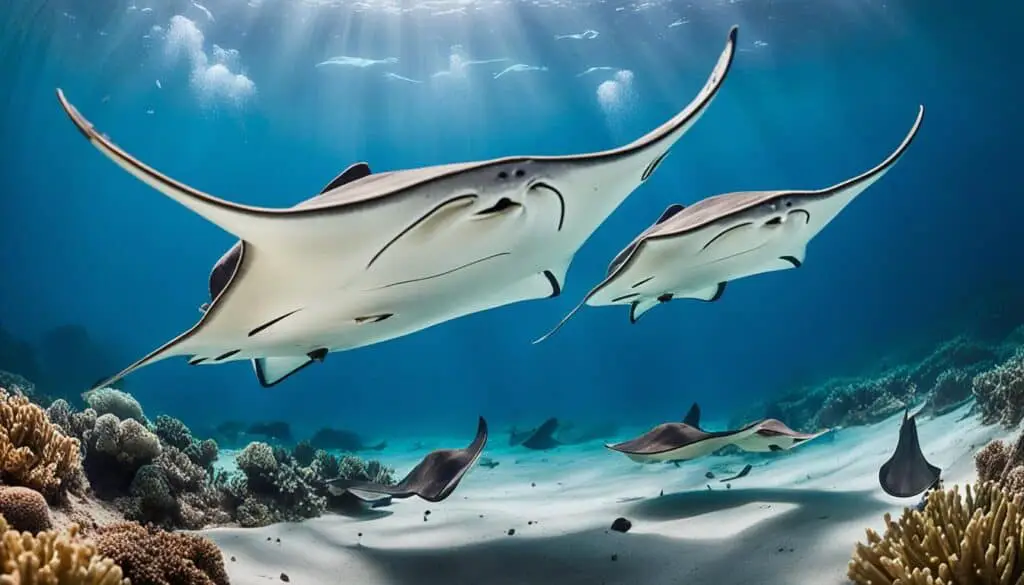
Learning about stingray communication helps us see how they connect with other sea life. They adjust their ways to live better with the ocean’s creatures.
Impact of Environmental Changes on Stingray Interactions
Environmental changes are big news for stingrays in the ocean. Climate change and damage to their homes make life harder for them. These changes hurt their survival and how they act. They also affect the food they need to live.
Ocean acidification happens when more carbon dioxide goes into the ocean. This changes the ocean’s chemistry, hurting the food stingrays eat. With less food, stingrays have to find new ways to eat, which can lead to more competition. This can change how stingrays and other animals live together.
Loss of habitat from human activities makes things even tougher for stingrays. Places where they used to live and have babies are disappearing. This means stingrays have fewer babies, making it harder for them to live in groups.
Understanding how climate change affects marine life helps us see the big picture. We see why we need to act to save the ocean and its creatures. By knowing this, we can work to protect the ocean and its special animals.
| Environmental Change | Effect on Stingrays | Effect on Prey Species |
|---|---|---|
| Climate Change | Changes in foraging behavior and social structure | Altered migration patterns, decreased populations |
| Ocean Acidification | Reduced health and reproductive success | Weakened shellfish populations, critical food decline |
| Habitat Loss | Increased vulnerability and competition | Decline in available shelter and breeding grounds |
Conservation and the Future of Stingray Interactions
The conservation of stingrays is crucial for their survival and the balance in marine ecosystems. Many stingray populations are stable, but they face threats like overfishing, habitat damage, and climate change. These threats highlight the need for strong protective actions.
Improving management and restoring habitats can greatly help stingrays. By making marine environments healthier, we support a more resilient ecosystem. This supports diverse marine life. Raising awareness about stingrays’ importance can encourage more people to help with conservation. Together, we can protect stingrays and their homes.
Dealing with these environmental issues is key to sustainable marine life interactions. By focusing on stingray conservation, we help marine ecosystems thrive. This ensures a healthy underwater world for future generations.
FAQ
How do stingrays interact with other marine life?
Stingrays work with many sea creatures through their hunting, social life, and ways of talking to each other. This shapes their place in the ocean.
What are the characteristics of Southern stingrays?
Southern stingrays (Hypanus americanus) have a flat, diamond-shaped body. They are often olive-green or brown, helping them blend in with the ocean floor.
What feeding habits do stingrays exhibit?
Stingrays hunt on the ocean floor at night and also during the day. Their eating habits and their place in the food chain are key to keeping the ocean balanced.
How do stingrays show social behavior in the ocean?
Stingrays can be alone or hang out in groups during mating. This helps them find mates and stay safe from predators. They change how they interact with each other based on their surroundings.
What types of communication do stingrays use?
Stingrays use special smells to find mates. They also touch each other, like nudging or biting, to show who’s boss or to be aggressive.
How do environmental changes affect stingray interactions?
Changes in the environment, like climate change and losing homes, can mess with stingray numbers and how they interact with others. This impacts their hunting and social life.
What conservation efforts are important for stingrays?
Saving stingrays is vital. We need to fix their homes, fish responsibly, and teach people about their importance in the ocean.

